WWII JAPANESE ARMY SAMURAI SWORD - KATANA - #1 -
The number of Samurai swords found in the US is greater than those found in Japan. After WWII. US soldiers
captured and brought back many swords. The item featured here is one of the swords that was
brought back.
The Katana is one of the most recognizable swords in history. Its strength, simplicity in
design and out right beauty has elevated it to be one of the top military antiques and
is highly collectible.
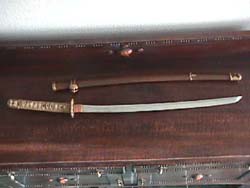
This is a WWII Japanese Army Samurai sword. A Katana. The Katana was developed in the
Azuchi-Momoyama period, between 1574 to 1602. These types of swords measure between 24" to 30".
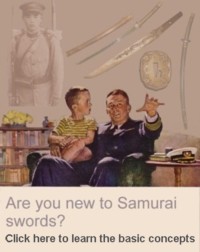
|
The Samurai sword has a very rich history. The sword has been manufactured for several centuries and continues
to be produced today. The sword represented more than just a weapon. It was the soul of the Samurai warrior.
When attempting to identify the type of sword you have It is important to keep in mind that the fittings of
a sword (scabbard, handle, crossguard. etc.) may be identical from one sword to another. The reason why is
because during WWII the same fittings were used in all Army swords, Navy swords, etc. Armed forces are all
about uniformity. They strive to make everything the same.
This is the reason why a sword cannot be identified merely by its external appearance.
Understanding the different components that make up the Samurai sword is the first step in figuring out the
type of sword you have. That is the reason why we have created the
Understanding the Samurai sword section as a means to
provide a novice with the basic knowledge to start the path of determining the questions everyone has;
who made the sword, how old it is nad how much it is worth.
|

Sword and scabbard are positioned side by side. Most blades were under 30 inches in length,
however, some swords reached lengths of 31 to 32 inches. The blade on this sword is fairly old
but it is not in the best condition. This fact hurts the value of the item.
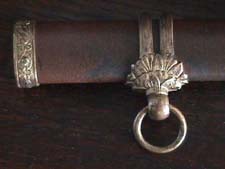
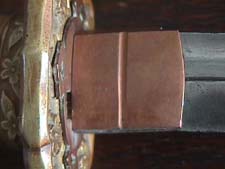
This picture provides a good example of WWII fittings which include: The fuchi
, decorative band on the left side. A side view of the tsuba or hand guard and
the kuchigane, which is the throat fitting located to the right of the tsuba.
The kuchigane on this photograph is secured to the scabbard by a screw.
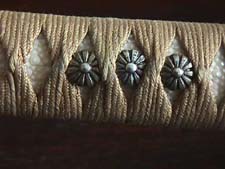
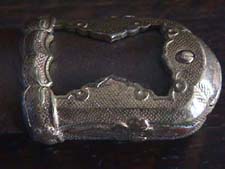
The manuki (handle ornament) displayed on the picture on the left is not an original piece.
It appears that at one point the fittings of this sword were replaced. The picture on the right shows
the piece attached to the bottom of the scabbard.
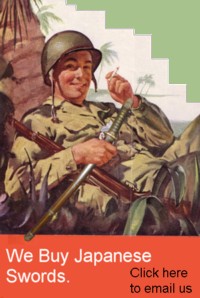
|
WE BUY JAPANESE SWORDS - All types of Japanese edge weapons. Whether it is a WWII era Samurai sword or an
older type of blade.
The process gets started by you sending us an
Email .
We will respond to your inquiry normally within 24 hours and in many cases much faster.
We can tell you what you have, what it is worth and how much we can pay you.
One sword or an entire collection -
Email Us .
|
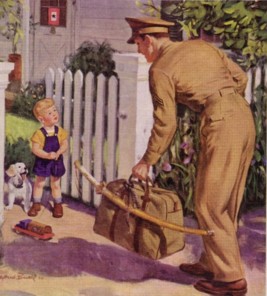 |
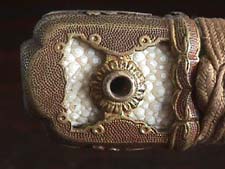
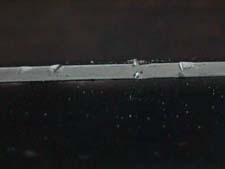
Close up picture of the kabutogane or pommel. This piece is painted in
military brown colors. A cloth sling would be threaded through the opening on the
pommel. The picture on the right provides a view of the top of the blade. What is interesting about
this sample is that it has several nicks that appear to have been made by another sword. When a Samurai
engaged in combat he would block the opponents blade with the top of his sword so as to avoid damage to
the cutting edge.
Unknown marks inscribed on the blade itself. Notice the grinder marks on the blade.
Unfortunately but a common occurance, many of the GIs who brought the swords back to the U.S.
sharpened them the way a regular knife would have been sharpened, causing severe damage to
the blade. The picture on the right shows the Ito groove. The purpose of the groove is to lighten the blade
and is a common feature seen on modern day Iaito blades which never touch blood. This feature can be confused with
a blood groove. However, blood groves are employed in stabbing weapons to allow increased
blood flow from the wound, a katana is predominantly a cutting weapon and would be
unlikely to need a blood grove and many do not. Also featuring a Ito groove can
slightly compromise the strength a blade to resist a blow from another sword so were
only ever added to lighten a blade to make it more manoeuvrable for some one of less
strength.
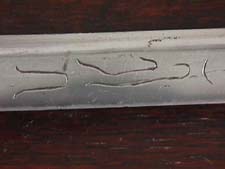
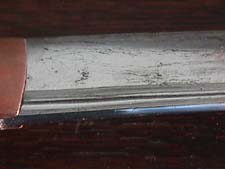
|
This page is a recognition and identification guide for Samurai swords.
Multiple detailed photos of a specific sample are provided. Descriptions point
out clearly defined points that should be noted.
One of the most commonly asked questions is "How much is my Samurai Sword worth?".
A price guide is included here to address this question. The value of the swords is
reviewed over a period of several years. A trend can be observed. The present worth
of the edge weapons in the collector's market is illustrated.
This service is provided free of charge to the visitor/enthusiast courtesy of
MilitaryItems.com,
a company dedicated to the preservation of military history and to providing quality
military antiques and collectibles to museums, institutions and the general public.
|
|
By the Numbers
It is next to impossible to determine the exact number of Samurai swords that were produced and issued to
Japanese soldiers during the war. However, thanks to the record keeping maintained by the US Armed Forces,
it is possible to estimate how many swords were actually shipped home.
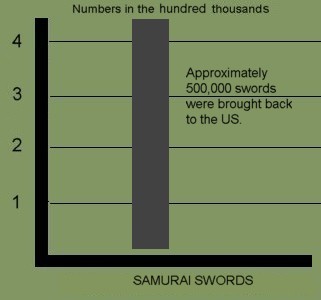 |
There were over 500,000 Samurai swords were brought back home as souvenirs from the war.
There are several caviats to this number.
|
 |
For example, some soldiers took souvenirs and shipped them home circumbenting the established process.
Some of the swords were brought back inside duffle bags without anyone knowing except for the soldier who
captured the sword. This fact would clearly affect the final count.
The number also does not account for swords that were taken by Allied soldiers from other countries.
Collecting Samurai swords
Collecting Samurai swords is a field that has been growing since the days the GI's rummaged around Asia
bringing back military souvenirs. Japanese soldiers carried many of these swords when they went to
battle. Once the soldier was killed or captured, the Americans would take the edge weapons as war trophies.
Eventually all these pieces came back to the United States where military history enthusiasts began to collect them.
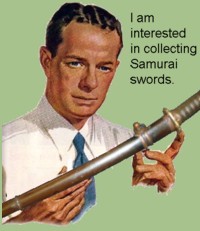 |
In trying to determine if you should collect Samurai swords there are certain factors that should be
considered.
The adjacent table outlines some of the advantages and disadvantages of collecting the Samurai swords.
|
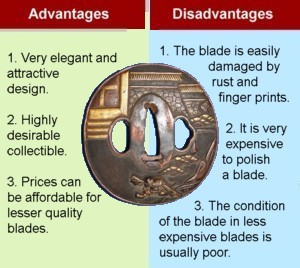 |
This Samurai Sword may be currently reproduced.
It is becoming more difficult to be able to tell the fake ones from the real ones because
the quality of the reproductions is improving. The collector must become familiarized with
the construction style and materials employed in the manufacturing of this item.
Attention to the details is critical in order to be able to determine the authenticity of
the collectible.
If you have an interest is seeing other Japanese Samurai swords, you can do so by going to our
Japanese Samurai Swords Price Guide
identification guide. Where we cover Samurai swords from all periods.
| 




